Iga city [伊賀]
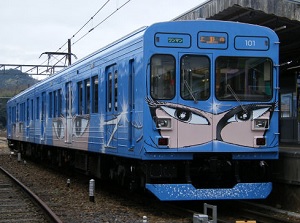
Ninja train of Iga Railway
Photo by Railstation.net
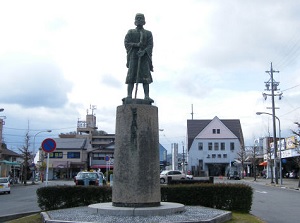
Statue of Basho in front of Ueno-shi station
Photo by Railstation.net
Iga is a city in Iga Basin located at the west part of Mie Prefecture.
Especially, the central district is called Iga-Ueno (伊賀上野).
In the 16th century, Iga-Ueno Castle was built.
Then, Tôdô family entered this castle as the feudal lord of Iga area.
Since that, this district developed as the castle town.
Iga area is known for Ninja (忍者).
Ninja was the member in the groups of secret agents like spy in the feudal periods (From the 14th to the middle of the 19th centuries).
Iga Basin had clayish soil, so it had been hard to farm.
Therefore many farmers in Iga worked as ninja to get income.
It is said that they had been trained hardly to become ninja from their early age.
(About ninja, see this page.)
One more famous person in Iga is Matsuo Basho (1644-1694).
He had completed "haiku", the short poem composed with only 17 syllabic sounds in Japanese.
He created many haiku with high artistic quality.
Especially, he often travelled, and many excellent haiku were created in the places where he visited.
Japanese people learn some of his famous works at school, so we can recite them.
By the way, a few researchers say that he was a ninja and his travels were done for spy missions.
Of course, it is unknown whether it is true or not.
Iga-Ueno Castle (伊賀上野城)
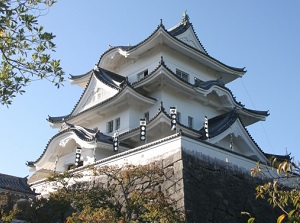
Iga-Ueno Castle
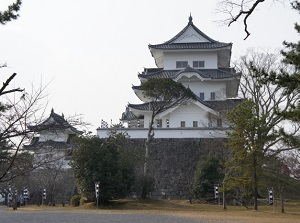
Iga-Ueno Castle
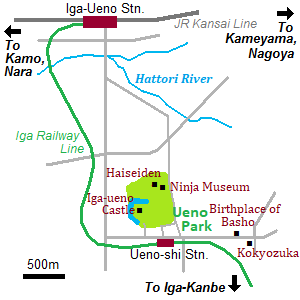
Iga-Ueno Castle is a castle in Ueno Park at the central Iga-Ueno district.
It was built in 1585, and the expansion work was started by order of Tokugawa Ieyasu, the founder of Edo Government and the first Shogun, in 1611.
But the work was canceled in 1615, and the incomplete castle was used without modification after that.
After the end of Edo Period (1603-1868), the castle was demolished.
Then, the site was changed to the park.
And the castle tower was restored as the historic building in 1935.
There is a museum about the history of Iga-Ueno inside the castle.
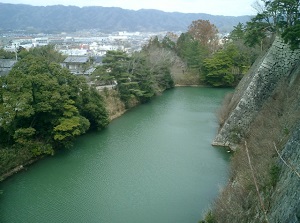
Moat of Iga-Ueno Castle
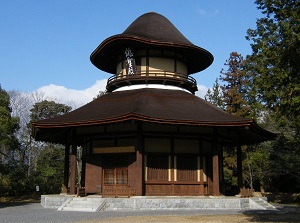
Haiseiden
Photo by Railstation.net
Haiseiden (俳聖殿)
Haiseiden is a building built in 1942 for the 300th anniversary of Matsuo Basho's birthday in 1942.
It is also in Ueno Park.
It isn't a temple, and there is a ceramic statue of Basho in the building.
October 12 is the annivaersary of the death of Basho, and Basho Festival is held here.
The statue is opened to the public only on the day, and the excellent works of new haiku applying from all over Japan are offered to the statue.
Iga-ryu Ninja Museum (伊賀流忍者博物館)
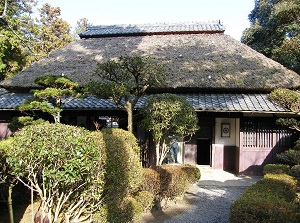
Iga-ryu Ninja Museum
Photo by Railstation.net
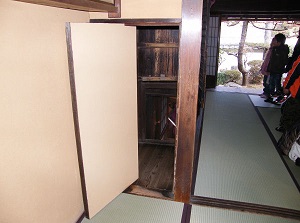
Trick room in Ninja Museum
Photo by Railstation.net
Iga-ryu Ninja Museum is a museum introducing Iga Ninja, and is also in Ueno Park.
"Iga-ryu" means a school of Ninja in Iga area.
There is another famous school of "Koka-ryu" to the north of Iga area.
This museum is like a theme park, and female guides dressed as ninja conduct the visitors into the museum.
(Female ninja is called "Kunoichi" as slang, but the existence is not known.)
The building looks like a traditional farm house, but it is a Ninja house with various tricks.
The guides show the tricks in the house.
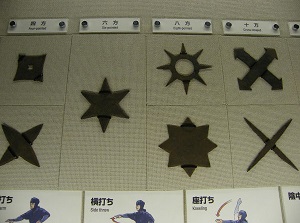
Ninja weapons
Photo by Railstation.net
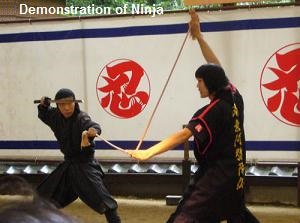
Demonstration in Ninja Museum
In the exhibition room, we can see various weapons of ninja.
And we can enjoy the demonstration of ninja.
The actors are the real descendants of Iga Ninja.
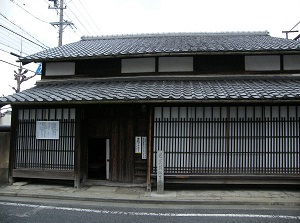
Birthplace of Basho Matsuo
Photo by Railstation.net
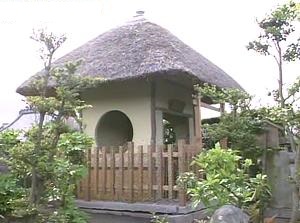
Kokyozuka in Iga-Ueno
Birthplace of Matsuo Basho (松尾芭蕉生家)
Matsuo Basho was born in 1644, and the birthplace is located about 0.8 km east of Ueno Park.
His father was a farmer, so the house was humble.
He served a samurai in this city and learned haiku.
He left for Edo (current Tokyo) in 1675, and had a relationship with many haiku poets.
And, he raised haiku to an art throughout his life.
Kokyôzuka (故郷塚)
Kokyôzuka is a mound for Matsuo Basho in Aizen-in (愛染院) temple near his birthplace.
He was dead in Osaka in 1694.
His disciples brought back his hairs, and buried them in this mound.
Aizen-in temple had been the temple of Matsuo family.
"Kokyô" means "hometown", and "tsuka (zuka)" means "mound".
How to get here
By railway (From Nagoya)
By limited express of Kintetsu railway, about 1 hour to Ise-Nakagawa.
Change to the limited express to Osaka-Uehonmachi or Nanba.
About 23 minutes to Iga-Kanbe.
From Iga-Kanbe station, about 27 minutes to Ueno-shi station of Iga Railway.
Or, by local train of JR Kansai Line, about 1 hour and 20 minutes from Nagoya to Kameyama.
Change to the train for Kamo.
About 45 to 50 minutes to Iga-Ueno.
From Iga-Ueno station, about 7 minutes to Ueno-shi station of Iga Railway.
By railway (From Osaka)
By limited express of Kintetsu railway from Osaka-Uehonmachi or Nanba, about 1 hour to Iga-Kanbe.
From Iga-Kanbe station, about 27 minutes to Ueno-shi station of Iga Railway.
Or, by local train of JR Kansai Line (Yamatoji Line), about 50 minutes from Ten-noji to Kamo.
Change to the train to Kameyama.
About 38 minutes to Iga-Ueno.
From Iga-Ueno station, about 7 minutes to Ueno-shi station of Iga Railway.
By express bus
From Meitetsu Bus Center near Nagoya station, about 1 hour and 50 minutes.
From Shin-osaka station, about 2 hours.
From Osaka station, about 1 hour 45 minutes.



